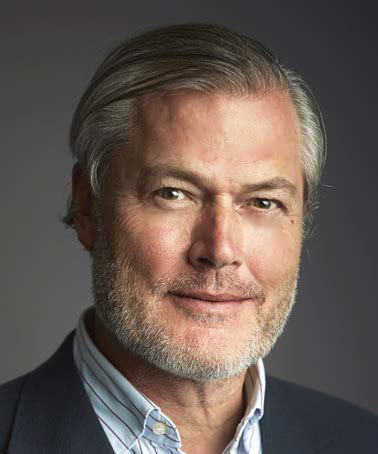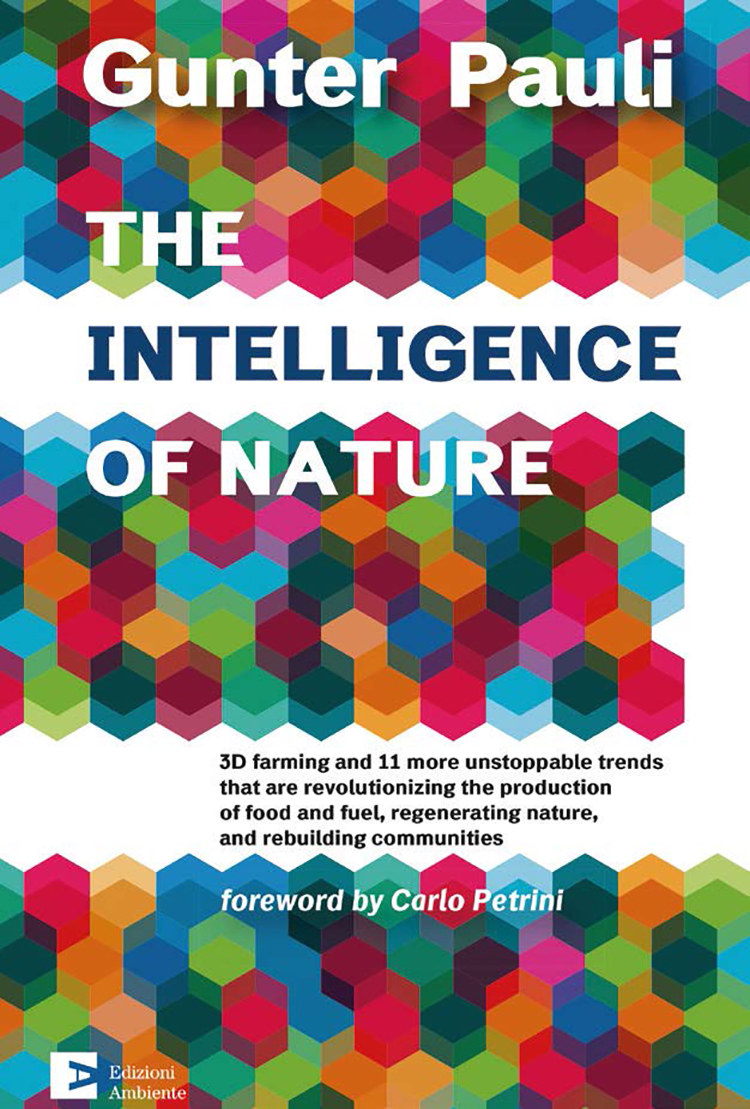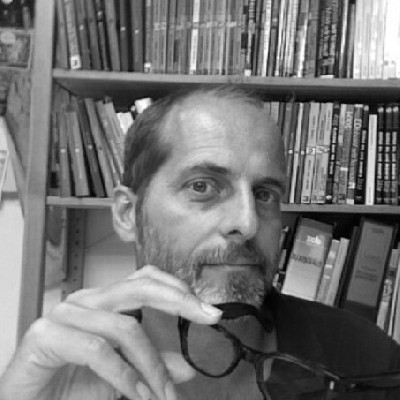 Non-conventional is the standard definition of Gunter Pauli’s ideas. The visionary entrepreneur from Antwerp has always tried to overthrow the rules of neoclassical economics, with an ability for considering the far-off future and recent history, infinite complexity, and always in search of new paradigms. In his latest work, The Intelligence of Nature, he delves deep into food production models. Renewable Matter took the time to sit down with him in a Milanese café for a long chat on the topic.
Non-conventional is the standard definition of Gunter Pauli’s ideas. The visionary entrepreneur from Antwerp has always tried to overthrow the rules of neoclassical economics, with an ability for considering the far-off future and recent history, infinite complexity, and always in search of new paradigms. In his latest work, The Intelligence of Nature, he delves deep into food production models. Renewable Matter took the time to sit down with him in a Milanese café for a long chat on the topic.
In your latest book, where you retouch on Blue Economy principles, you mention that the current approach to food production is oversimplified and small minded. What are the main features of current “mainstream agriculture” that have pushed you towards the formulation of this opinion?
“Nowadays everything is standardised. We treat the production of tomatoes as we would the production of cars. Cars are made of metal and they are machines. Tomatoes are life. Yet, a tomato that is completely devoid of its true taste is devoid of life, and I don’t think you would need to convince any inhabitant of the Mediterranean of this, where the forces of life have manifested themselves in an even more spectacular fashion than many other locations!
To answer the demand for food in the global marketplace: industry, science and politics have chosen the route of standardisation. This means that today, as consumers, we expect to find the same types of tomatoes all over the world, the same corn everywhere. We have denied biological and climatic diversity. In the face of increasing drought, we answer with genetic modifications rather than using plants that have adapted and are suited to dry conditions.
Therefore, the model is standardisation and in particular standardisation guided by price. Today everything is directed by price, as this answers to the logic of conventional economics: if food is less expensive then it will be accessible to a greater amount of people. However, it is this very logic that has led to us treating soil as an extractable resource. We often denounce the negative effects of mining practices on the quality of our air, water and wellbeing. Yet, agriculture has become an activity of extraction of carbon from soil. Without the carbon found in soil there is no water retention and there will be a need for ever increasing quantities of water to guarantee soil fertility. We also know that currently 70% of global drinking water is used for irrigation, a trend that is in constant growth, because we have completely forgotten the role and importance of carbon in soil.
The current agro-food system is on the brink of collapse. It is only kept together through the ever greater use of ever more powerful fertilisers. The answers we give for this crisis in soil quality are influenced by the desire to produce greater and greater quantities of the same thing. The answers are genetics and chemistry: pesticides, herbicides and fungicides are our answers. To this you have to add all the conservatives we use on fruit, because the use of chemistry doesn’t just stop in the field. Starting from the seed which is subject to chemical treatment, and finishing with the food which is also treated both directly and through its packaging.
When we look at this chemical cocktail we have to be aware that it isn’t just our soil that we are depleting but food itself. We are changing the way in which we are used to thinking of food, defining it differently from the German word Lebensmittel whose etymology suggests food as a means and instrument for life. For food to continue to be a means for life then we have to guarantee its wellbeing, whereas what we are using now is chemistry; whose contributions may even be beneficial when taken singularly, but whose effects on our body, when taken as a chemical cocktail, remain untested. The fundamental contradictions of the current agro-food system are therefore the consumption of water and soil, the production of food at ever lower costs (and price), and an obsession with chemistry.
When we look back on today’s practices in 50 years time, we will wonder how was it possible for there to be so much stupidity, how was it possible that we eliminated the orang-utans natural habitat just for some palm oil and the production of biscuits to be sent around the world wrapped in plastic.
And in all this what I ask myself is: where is it that we are generating profit? Profit is generated in the transformation phase. We all know that it isn’t in farming that real money is made, too many farmers are suffering. The money lies with those that create the final product to be sold to consumers.
Therefore, maybe it is in the very system currently in vigour that we can find the ingredients for the creation of a new agro-food system. It is here that we need to look, rather than a revolution that stops the current system, we need to identify what features are making it work and how these ingredients can be applied as elements in a new virtuous model of production and consumption.”
This is what you propose in your call for a transition from a two-dimensional system to a “three-dimensional” one. If agriculture today only thinks in terms of flat geometries, what is this third dimension that we can’t see and which we have forgotten?
“Today, by combining the best genetics with chemical excellence, you can obtain around 20 to 25 tonnes of biomass from a hectare of land.
A rainforest typically produces 500 tonnes of biomass per hectare.
If the objective is to feed the planet we have to operate as a rainforest, the very ecosystem that we are currently destroying to make way for monocultures and justifying our destruction with the idea that this is the price to be paid for the difficult task of feeding the world. Yet, numbers clearly indicate that this is not the case: what we have to do is ask ourselves what produces this huge difference. In a hectare of space, Kelp forests (laminaria digitata seaweed) can grow quite a few meters underwater and produce up to a thousand tonnes of biomass. And, whilst industrial players claim that ‘ok, but no one wants to eat that stuff,’ they continue to submerge us in junk food. If we managed to make hamburgers from Mc Donalds tasty, how can we think that it is impossible to do the same thing with seaweed? Obviously not!
What we truly need is the productive levels of rainforests, that don’t deprive, but rather nourish, the fertility of soil. To obtain this the essential condition is to bring carbon back into our soil. Rainforests, even if they grow in impoverished soil, are able to complete this cycle of regeneration. Indigenous populations know this all too well, whereby their methods of collaboration with nature so as to conserve soil fertility form a fundamental part of their cultural heritage, just as the famous terra preta in the Amazon rainforest demonstrates.
Nature is giving us a clear message: give me three dimensions, let me grow in height so as to protect the life that would otherwise be destroyed by ultraviolet rays. The ability to work in 3D allows for the creation of a dense biomass that would otherwise be impossible if all attention was focused exclusively on the cob of corn and if we suppose, as we normally do, that ‘fertilisers are not to be used to grow the stalk.’
If everything has to go toward the cob what we obtain is a two dimensional approach to farming, that gets ever closer to the soil, so as to ensure that fertilisers go straight to the cob and chemistry is more efficient in increasing productivity.
In 3D agriculture the density develops in height, just as occurs in rainforests where the highest density of plant biomass is 20 or 30 meters up, and whose value is shared with other life forms. If the objective is productivity, then let’s look at water, which has a further advantage, its density: water is 700 times denser than air and therefore more rich in nutrients. It is curious how today we focus on hydroponic cultivation where only roots are immersed in water, when up to a depth of 20 meters thanks to filtering light, a plant that is completely submerged can fully indulge in the maximum supply of nutritional substances that float around in water. 3D agriculture, as you can see, is biomimicry, because nature is made to reproduce itself. And, anyone who has a basic understanding of geometry can immediately grasp the added value of using three dimensions instead of two. Therefore, why should agriculture only focus on our plains or worse?
Why does genetics only aim to bring crops ever closer to the soil? I think that here we are mistaken, and that today those that are involved in biomimicry should look to the physical space in which agriculture places itself, instead of focusing on insects and single plants. There are marvels everywhere in nature, but the true marvel is the way in which it uses the three dimensions of space, and there is no doubt that today we can practice agriculture that imitates this capacity.
What experience do we have in the use of the three dimensional space in agriculture? With greenhouses we try to create an environment that has a controlled atmosphere, yet once again without comprehending the functional models of nature. Because, the way in which engineers consider nature to operate has nothing to do with the way in which it truly functions. In a greenhouse, so as to grow tomatoes and salad during the winter, we heat the air with huge energy costs and generating a high amount of water evaporation. Hence we have to water and use irrigation, and greenhouses are renowned consumers of high quantities of water per square meter. What is the problem? It is that we have forgotten that plants not only need hot air so as to grow leaves, but also need a difference in temperature between leaves and roots which is what allows them to have an optimal flow of nutrients to the plant.
We invented drip irrigation, a big business for those that produce these systems, when it is nothing more than that which nature always tends to create, an environment that has a sufficient difference in temperature between soil and that which grows above it to generate morning dew (depoint). In nature it is dew that has provided ‘drip irrigation’ every morning for millions of years. Something else that we have forgotten.
Let us consider another factor: light, questioning how much light plants require and what kind of light. Today we use led lights to keep greenhouses lit constantly. Led light is interpreted by plants as ‘daylight,’ yet they do not require constant daylight, but rather the change that occurs between dawn and dusk, that generates different chemical processes in the two types of chlorophyll present in plant organisms. Chlorophyll that allows the plants, even on the basis of minimal differences in the light frequency, to ‘know’ in which part of the world they are and what day of the year it is.
Using techniques that are capable of simulating these natural processes will still allow us to reach desired results, and get our salad in two weeks without added chemicals, genetics or drip irrigation. This is where we have made a mistake, in not taking the time to properly understand how nature works, instead always choosing what are perceived as shortcuts.”
Do you think that other sectors could also benefit from a 3D model of agriculture? Can the relationship between farming enterprises and other productive processes change?
“I believe that never before in history have we considered agriculture exclusively as the ‘activity that produces food.’ It is a simplification that today has brought us to the point where we produce millions of tonnes of cereals to feed livestock. It is absurd to think of agriculture as being solely responsible for the production of food, because it is intrinsically connected to areas such as the textile sector and chemistry, or even with the issue of water, and finally with culture in general. You can’t separate the word ‘culture’ from ‘agriculture.’ What we have done is to actually transform ‘agriculture’ into ‘agroindustry.’ This is the reason why we need people like Carlo Petrini (read his article in the preceding pages) that recall the unbreakable link between culture and agriculture, and mobilise millions of people that are willing to change the current system. You can’t separate activities that impact the development of a region: agriculture, chemistry, transport, everything has to be coordinated as an integrated system, and you have to start from what an area has, and then think of what it may need. It is here that economists are mistaken: they just look at what a territory needs out of the desire to create a market, because if there is no need for a market… how can you create business? This induces a mentality whereby we always feel like we have too little. The economist arrives and says ‘you are too small to compete, better not try,’ and this way farmers leave their fields and fertile soil is transformed into abandoned land.
We need a profound change in our way of thinking. If we don’t do this we will lose important business opportunities, but we will also lose the possibility for entire areas to develop. This is exactly the direction we have been going in up until now, a direction that has led to crisis, the abandoning of agricultural practices by younger generations, and the reduction of everything to market competitiveness on commodities markets. All of which makes the positive effects of the adoption of a different model, and the cascade effects that this model would bring, utterly superfluous. A model that would allow us to think outside of core business in a system that integrates agricultural production, renewable energies and new chemistry.”

G. Pauli, The Intelligence of Nature, 2018 Edizioni Ambiente www.edizioniambiente.it/libri/1218/the-intelligence-of-nature
Twitter: @MyBlueEconomy
Keynote Speech: Prof. Johan Rockström & CEO Pavan Sukhdev, www.youtube.com/watch?v=tah8QlhQLeQ



